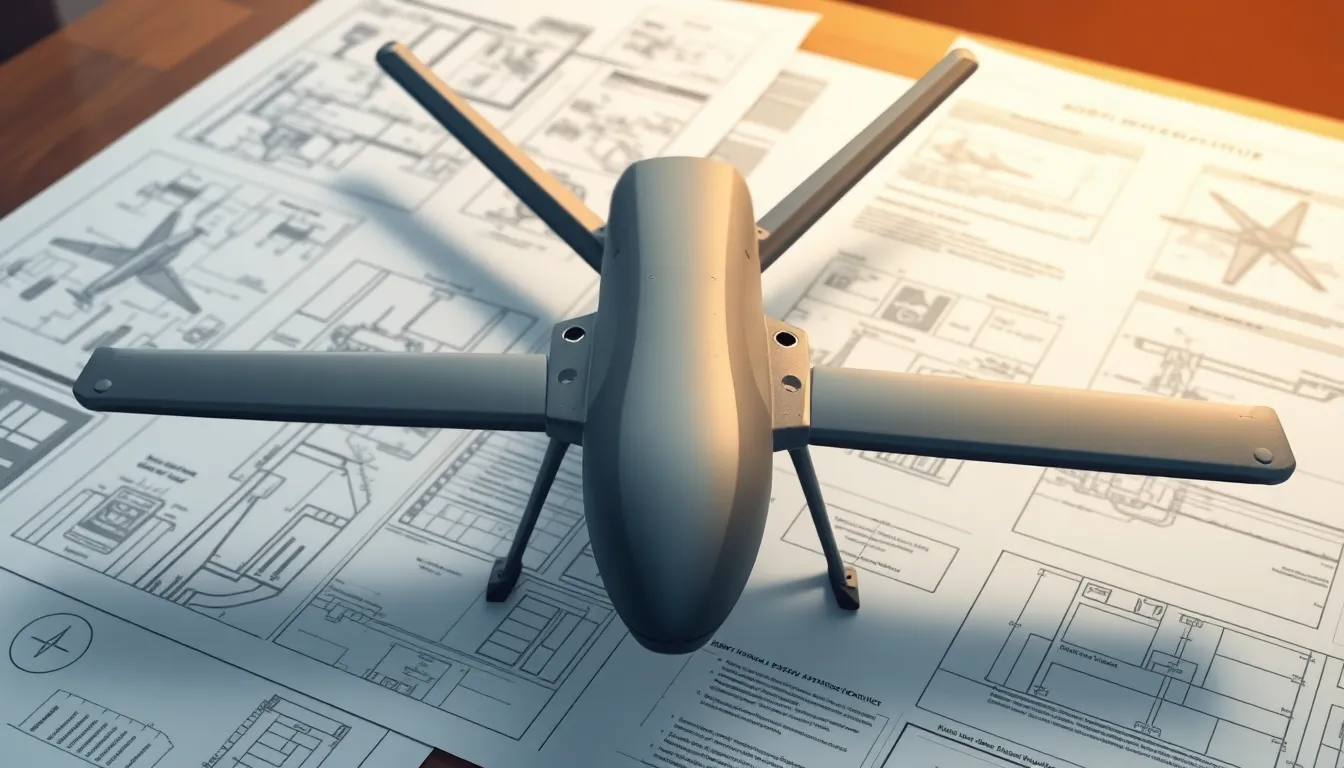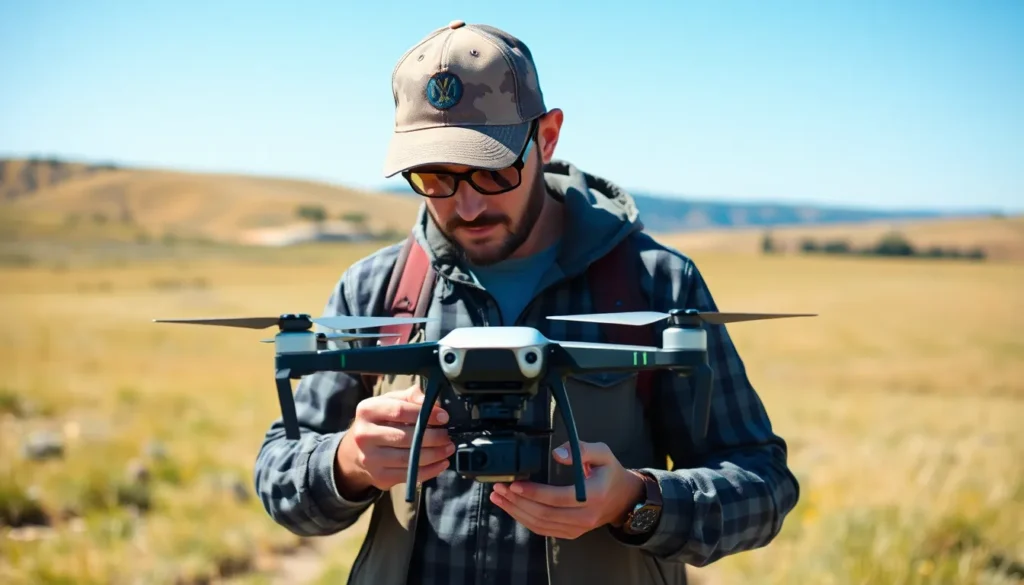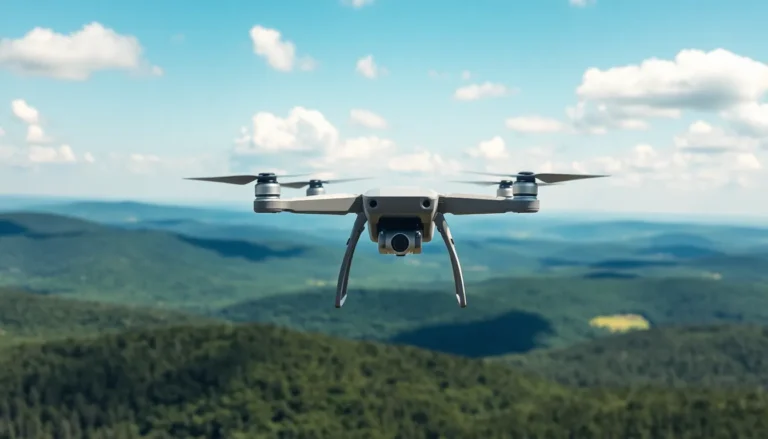In a world where drones are buzzing around like caffeinated bees, understanding Drone NDAA compliance is more crucial than ever. Whether it’s for commercial use or fun weekend adventures, staying compliant is the key to flying high without crashing into legal trouble. After all, nobody wants their drone to become a flying paperweight because of a compliance issue.
Table of Contents
ToggleOverview of Drone NDAA Compliance
Understanding Drone NDAA compliance serves as a critical aspect for anyone involved in the use of drones. Compliance entails adherence to the National Defense Authorization Act (NDAA), which primarily focuses on national security issues. Specific provisions within the NDAA prohibit the use of certain foreign-made drones, especially those manufactured by companies deemed a threat to U.S. national security.
Manufacturers and users must ensure their drones comply with these requirements to avoid legal repercussions. The compliance process involves verifying that drones do not include components from restricted companies. Checking supply chains for compliance is essential, as companies need to source their parts from approved sources only.
Companies producing drones for government contracts face additional scrutiny. Compliance with forfeiture of procurement contracts may occur if they fail to meet NDAA standards. Surveillance and data security also come under review, reflecting an essential public concern regarding user data privacy.
Detection of non-compliance can lead to significant penalties. Businesses may find themselves barred from participating in federal contracts if found in violation of the NDAA. Ensuring proper certification of drones enhances the safety of operations across various sectors.
Staying updated on NDAA regulations ensures that all stakeholders remain vigilant. Regular training for employees on compliance measures can minimize risks associated with using drones. Compliant operations not only protect national interests but also bolster public trust in drone technology.
Key Regulations Under NDAA

Understanding key regulations under the National Defense Authorization Act (NDAA) is crucial for drone manufacturers and users. Familiarity with these regulations aids in ensuring compliance and mitigating potential risks.
Definition of NDAA
The National Defense Authorization Act (NDAA) outlines the budget and expenditures for the Department of Defense. This legislation establishes policies for military functions, including procurement, personnel, and research and development. Relevant to drones, NDAA provisions specifically address national security concerns by controlling foreign influence in U.S. defense technology. Such oversight is vital for maintaining the integrity of defense systems and protecting national interests.
Relevant Sections for Drones
Several sections within the NDAA focus on drones and related technologies. Section 848 restricts the use of drones manufactured by companies with ties to nations deemed as security risks, particularly those located in China and Russia. Additionally, the NDAA emphasizes supply chain transparency, requiring manufacturers to disclose any foreign components used in their drones. Compliance with these provisions helps safeguard against espionage and ensures that government contracts are awarded only to trusted entities. Increased scrutiny is placed on bidders for federal contracts, reinforcing the importance of adhering to NDAA guidelines.
The Importance of Compliance
Understanding Drone NDAA compliance is crucial for manufacturers and users within the drone industry. Adhering to these regulations fosters trust and safety, protecting both entities and national interests.
Benefits for Manufacturers
Manufacturers benefit significantly from compliance. Protecting their reputations becomes a priority when they ensure adherence to NDAA regulations. Securing contracts with government agencies requires demonstrating compliance with sections like 848, which restricts the use of drones from certain foreign entities. Companies that follow these guidelines enhance their chances of winning contracts. Streamlining supply chain management further mitigates risks associated with restricted components. Staying informed about evolving regulations positions manufacturers competitively in the market.
Implications for Users
Users must recognize the implications of compliance on their drone operations. Non-compliance risks severe repercussions, including legal penalties and confiscation of drones. Trust in drone technology increases when users operate compliant equipment. Utilizing drones manufactured according to NDAA regulations guarantees safer operations while protecting sensitive data. Understanding the limitations set by the NDAA helps users make informed purchasing decisions. Engaging in regular training ensures users stay updated on compliance requirements, fostering safer and responsible drone use.
Challenges in Achieving Compliance
Achieving compliance with Drone NDAA regulations presents several challenges. Organizations navigating this landscape face both technical barriers and regulatory hurdles that require attention and action.
Technical Barriers
Technical barriers often complicate adherence to NDAA compliance. Ensuring that drones contain no components from restricted foreign manufacturers poses significant challenges. Companies must invest in comprehensive supply chain audits to identify potential vulnerabilities. Data management systems should be employed to trace the origins of drone parts effectively. Manufacturers often encounter difficulties verifying the compliance of third-party suppliers, as not all suppliers disclose their sourcing practices transparently. Compliance technologies can help mitigate these challenges by streamlining verification processes, yet they come with implementation costs.
Regulatory Hurdles
Regulatory hurdles can create complexities in achieving compliance with NDAA standards. The regulations often evolve, necessitating that organizations remain agile and informed. Organizations must allocate resources to stay updated on changes impacting compliance mandates. Compliance documentation must be meticulously maintained, as inadequate record-keeping can lead to legal and financial repercussions. Understanding the nuances of different NDAA provisions is crucial for manufacturers and users alike, as any misunderstanding may result in unintentional violations. Legal guidance may become essential to navigate these requirements successfully, ensuring adherence to both intent and letter of the law.
Best Practices for Ensuring Compliance
Compliance with Drone NDAA regulations requires diligent efforts and structured practices. Organizations must adopt strategies that align with current regulations while promoting transparency.
Documentation and Reporting
Accurate documentation plays a significant role in achieving Drone NDAA compliance. Companies must maintain comprehensive records of their supply chains, detailing component origins and supplier information. Reporting structures should be clear, ensuring timely updates on compliance status. Regulatory agencies often require reports that demonstrate adherence to NDAA provisions. Inadequate documentation can lead to severe penalties, including loss of contracts. Companies should also implement standardized templates for documentation to streamline processes and maintain consistency across all reports.
Continuous Monitoring and Auditing
Regular monitoring and auditing enhance compliance efforts and identify potential issues before they become problems. Organizations must establish a routine for conducting supply chain audits, assessing both internal processes and external supplier compliance. Proactive measures facilitate quick detection of unauthorized components, minimizing risks. Real-time monitoring tools can provide insights into supply chain operations, helping companies stay informed. Training personnel on the importance of continuous observation ensures a culture of compliance. Addressing findings from audits strengthens compliance practices and builds credibility with regulators.
Understanding Drone NDAA compliance is crucial for anyone involved in drone operations. Adhering to these regulations not only protects against legal issues but also enhances the reputation of manufacturers and users alike. By ensuring that drones are free from restricted components and maintaining rigorous supply chain management, organizations can mitigate risks and foster trust in their operations.
Staying informed about evolving regulations and implementing best practices will be vital for ongoing compliance. The landscape of drone technology is rapidly changing, and organizations that prioritize compliance will be better positioned to navigate challenges while safeguarding national interests. Investing in compliance today will pave the way for a more secure and responsible future in drone usage.





